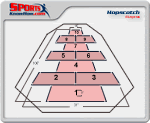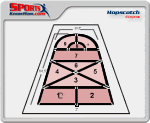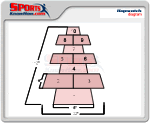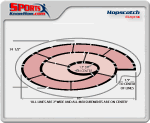Click on the Hopscotch court layout or the links below the layouts for printable or downloadable Hopscotch court diagram. Our diagrams show the size, measurements and layout of a Hopscotch court.
Hopscotch Court
Dimensions Diagram
Hopscotch Court Dimensions:
A standard hopscotch court is chalked on a hard surface (such as asphalt or concrete) or etched into soil, and may take several forms. The three standard types of hopscotch court designs are currently used
- Simple (Traditional or Standard) Layout
- Arched (English) Layout
- Snail Layout
There are, however, many other “freestyle” hopscotch courts frequently seen in schoolyard play. Each part of a freestyle court bears a number and players must hop down the length of the court, hitting the spaces in numerical order.
Simple (Traditional or Standard) Layout:
 The Simple (sometimes called the Traditional or Standard Layout) is series of 8 to 10 squares or rectangles arranged in a linear fashion. The typical simple layout has square number 1 followed by squares 2 and 3 in parallel. Those squares followed by square 4 and then 5 and 6 in parallel. This sequence is followed by square 7 then 8 and 9 parallel to each other topped by 10 as a home square or with a separate “home area” next to the 10 square.
The Simple (sometimes called the Traditional or Standard Layout) is series of 8 to 10 squares or rectangles arranged in a linear fashion. The typical simple layout has square number 1 followed by squares 2 and 3 in parallel. Those squares followed by square 4 and then 5 and 6 in parallel. This sequence is followed by square 7 then 8 and 9 parallel to each other topped by 10 as a home square or with a separate “home area” next to the 10 square.
The Simple Layout of 10 squares is usually 10 feet long and three (3) feet wide. Each square is approximately one and one half (1.5’) feet on each side.
Court sizes vary and the game can be played on a much less than perfect court.
Arched or English Layout

The Traditional English design is a series of numbered rectangles – usually 8 to 10 total, with the semi-circular “safe space” at the end.
Traditional Arched/English Layout court includes a more complex arrangement of rectangles and squares. There are usually four diamond-shaped spaces on an English court, created by drawing a large X in the middle of what would otherwise be a rectangular space.
The top of the court has a semi-circle “arch” at the top sometimes including one and up to three spaces.
The small squares in the arched layout are approximately one and one half (1.5) feet wide.
The middle square that is crossed is approximately three (3) feet on each side
The upper most rectangle box tops the crossed box and is as wide to match the underlying boxes.
The top arch consists of one, two or even three additional spots on the court, topped by a semi circle known as the arch.
The Snail layout, sometimes referred as “Escargot” follows the same type of rules that the other layouts enjoy. This layout is in the shape of a spiral and resembles a snail’s shell.
The typical size of this layout is from five (5) feet to eight (8) feet in diameter.
The snail layout will typically have between 8 and 10 landings with the Home space in the middle of the court.
Other Hopscotch Variations
Hopscotch Courts Around the World
Hopscotch and its regional variants are popular around the world, especially in Brazil, Spain, India, Germany, France and Iran. Most of these use a court that’s identical or similar to the three aforementioned court layouts.
Agility Hopscotch Courts
Agility hopscotch is another common variant. Agility courts are long, rectangular strips, bisected vertically; one half for the right foot, and one for the left. Each half is sectioned into squares, which are marked with either an L (left foot) or R (right foot). Players must hop all the way down the court and back again, but may only use the feet indicated in each square. The goal is to traverse the court as quickly as possible without being disqualified for using the wrong foot, stepping out of bounds or falling outside the court altogether. Agility hopscotch courts may be very long; the length of those that have 10 or 12 horizontal sections often approach twenty (20) feet, and more extensive courts will easily exceed that.
General Hopscotch Court Principles:
Although there is a great deal of variation in the size and configuration of a hopscotch court, there are general principles that are useful. The overall length of the court usually measures ten (10) feet to about fifteen (15) feet, with each rectangular “step” at least one foot to 18 inches in size.
Like almost everything else related to the game, Hopscotch court measurements are usually left up to the players’ wishes and abilities. A court for small children should, of course, have smaller squares than courts used by teens and adults. Players can also modify the court at will; if the course is too easy, they can add more squares to increase its difficulty, and if the design is too difficult, players may simply change it.

